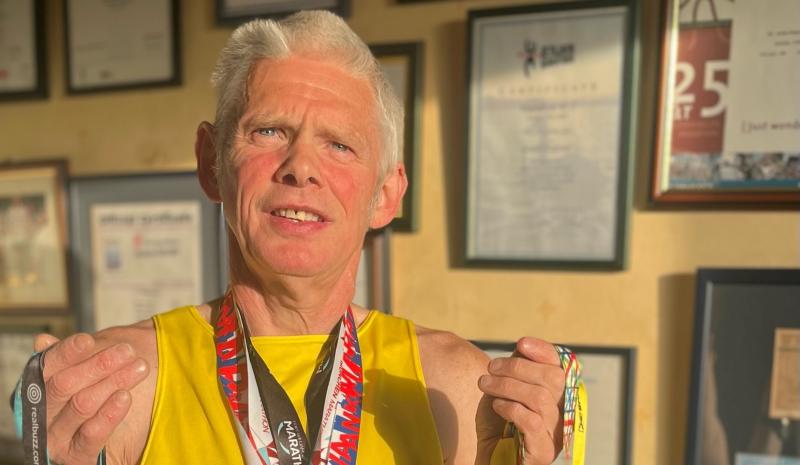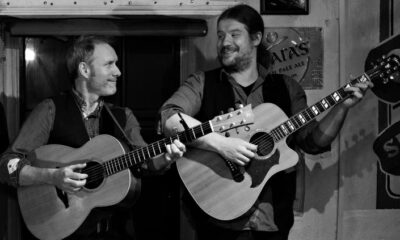News
Galway-born snapper has a different take on electioneering

A young Irish photographer with Galway roots is making a name for himself on the European stage – with a new book that offers a different twist on elections!
Mark Duffy had already been shortlisted for a number of prestigious awards before taking first prize at the Vienna PhotoBook 2015 for his new collection – with an original approach to the world of politics.
His book, Vote No.1, examines the culture of election advertising in Ireland. The images reflect the Irish electorate’s increasing disillusionment with the political process after years of harshening austerity politics
Born and raised in Galway, the Duffy family later moved to Athlone and Mark is now based in London.
However, his roots remain in Galway where his paternal grandmother, Peggy Duffy, still lives in St. Bridget’s Terrace in the city, at the ripe old age of 92.
Mark learned his craft from studying photography at IADT, Dún Laoghaire. After college, the young graduate, like so many others, emigrated to the buzzing metropolis of London to carve a career for himself. He has been residing in London ever since.
His PhotoBook, Vote No.1 focuses on the accidental, and often gruesome, disfigurements the electoral candidates’ faces suffer – an unintended consequence of their posters’ erection.
The idea came about after a trip home during the 2014 local election, Mark noticed a stark change in scenery – the city had changed face – festooned by thousands election posters.
Indeed, a visit to his beloved grandmother in Galway was to prove a source of inspiration for the creative photojournalist.
“The project actually started in Galway. The first photo I took was outside my granny Peggy’s house off Prospect Hill,” he said.
Inspiration came when Mark saw the large and disfigured image of a politician etched onto the side of a car.
The skewed portrait, he felt, was reflective of the political mood at that time. In a post-recession, disillusioned society, the smiles of politicians appeared disingenuous and somewhat sinister.
Following this ‘eureka’ moment, a heightened sense of awareness overcame Mark and he began to notice interestingly warped and disfigured faces all over the city.
“I saw a poster on the side of the road with a female candidate whose neck was punctured by the plastic tie holding it in place. It just looked so inch-perfect that it almost looked intentional. Then I just started seeing them everywhere … every lamppost covered with multiple candidates faces all vying for your attention,” he explains.
“The project was driven by humour and individualism,” he says, stressing .the focus was on accidental disfigurements’.
And he’s quick to point out – ‘posters were not altered or vandalised during the making of this series!’
With a watchful eye and camera in hand, the young photographer captured a handful of stills before flying to London.
On return, he mulled over the concept of a political-themed PhotoBook. “Straight away, the idea was for a book,” he says.
Whilst in London, Mark feared that “the idea was so straightforward, somebody else was bound to come up with it if I didn’t do something now” – and with that, he booked an immediate return flight to Ireland to see his project through to completion.
Addressing the rather Tarantino-esque brutal looking disfigurements, he says: “They were so perfectly placed – it was almost like it had been done by a disgruntled employee”.
‘Vote No.1’ has featured in various competitions and exhibitions across Europe, taking first prize at the Vienna PhotoBook Award 2015; this collection was also shortlisted for the prestigious LUMA Rencontres Dummy Book Award 2015.
Unfortunately he was forced to withdraw from the LUMA competition having won the Vienna PhotoBook Award.
“I’ve received great feedback from industry people,” he says.
He admits that it’s a niche market – but ‘Vote No.1’ has a print run of 500, a very healthy number within this exclusive market.
The special edition limited run of 100 is photographed by Harald Latzko and handmade by Mark, using recycled corriboard election posters and bound with cable ties.
“Essentially the book is bound by its very subject matter,” he observes. The remaining 400 are printed in hardback copies.
The success of this collection has helped establish his name both at home and abroad.
RTÉ’s former London editor, Brian O’Connell launched the London event, held at The Photographers’ Gallery in Soho. The Irish leg was held in Gallery of Photography, Temple Bar, and was launched by David Davin-Power, political correspondent for RTÉ.
The book was presented to An Taoiseach, at a recent 1916 event held in London, attended by David Cameron.
Last week, to Mark’s surprise a letter arrived from Oifig an Taoisigh – a thank you letter from Enda, himself: “I very much enjoyed my visit to the Photographer’s Gallery in London last week and I was delighted to receive a gift of your book ‘Vote No.1’”
“Your photographs certainly show election posters in a different light!” wrote the Fine Gael leader.
The timing seemed a little ironic, according to Mark, who jokingly remarked: “That’s the reason why the election date was held back – he had to reassess his campaign strategy!”
To check out Mark’s work visit his website
Connacht Tribune
West has lower cancer survival rates than rest

Significant state investment is required to address ‘shocking’ inequalities that leave cancer patients in the West at greater risk of succumbing to the disease.
A meeting of Regional Health Forum West heard that survival rates for breast, lung and colorectal cancers than the national average, and with the most deprived quintile of the population, the West’s residents faced poorer outcomes from a cancer diagnosis.
For breast cancer patients, the five-year survival rate was 80% in the West versus 85% nationally; for lung cancer patients it was 16.7% in the west against a 19.5% national survival rate; and in the West’s colorectal cancer patients, there was a 62.6% survival rate where the national average was 63.1%.
These startling statistics were provided in answer to a question from Ballinasloe-based Cllr Evelyn Parsons (Ind) who said it was yet another reminder that cancer treatment infrastructure in the West was in dire need of improvement.
“The situation is pretty stark. In the Western Regional Health Forum area, we have the highest incidence of deprivation and the highest health inequalities because of that – we have the highest incidences of cancer nationally because of that,” said Cllr Parsons, who is also a general practitioner.
In details provided by CEO of Saolta Health Care Group, which operates Galway’s hospitals, it was stated that a number of factors were impacting on patient outcomes.
Get the full story in this week’s Connacht Tribune, on sale in shops now, or you can download the digital edition from www.connachttribune.ie. You can also download our Connacht Tribune App from Apple’s App Store or get the Android Version from Google Play.
Connacht Tribune
Marathon Man plans to call a halt – but not before he hits 160 races

On the eve of completing his 150th marathon, an odyssey that has taken him across 53 countries, Loughrea’s Marathon Man has announced that he is planning to hang up his running shoes.
But not before Jarlath Fitzgerald completes another ten races, making it 160 marathons on the occasion of his 60th birthday.
“I want to draw the line in 2026. I turn 57 in October and when I reach 60 it’s the finishing line. The longer races are taking it out of me. I did 20 miles there two weeks ago and didn’t feel good. It’s getting harder,” he reveals.
“I’ve arthritis in both hips and there’s wear and tear in the knees.”
We speak as he is about to head out for a run before his shift in Supervalu Loughrea. Despite his physical complaints, he still clocks up 30 miles every second week and generally runs four days a week.
Jarlath receives injections to his left hip to keep the pain at bay while running on the road.
To give his joints a break, during the winter he runs cross country and often does a five-mile trek around Kylebrack Wood.
He is planning on running his 150th marathon in Cork on June 4, where a group of 20 made up of work colleagues, friends and running mates from Loughrea Athletics Club will join him.
Some are doing the 10k, others are doing the half marathon, but all will be there on the finishing line to cheer him on in the phenomenal achievement.
Get the full story in this week’s Connacht Tribune, on sale in shops now, or you can download the digital edition from www.connachttribune.ie. You can also download our Connacht Tribune App from Apple’s App Store or get the Android Version from Google Play.
CITY TRIBUNE
Galway ‘masterplan’ needed to tackle housing and transport crises

From the Galway City Tribune – An impassioned plea for a ‘masterplan’ that would guide Galway City into the future has been made in the Dáil. Galway West TD Catherine Connolly stated this week that there needed to be an all-inclusive approach with “vision and leadership” in order to build a sustainable city.
Deputy Connolly spoke at length at the crisis surrounding traffic and housing in Galway city and said that not all of the blame could be laid at the door of the local authority.
She said that her preference would be the provision of light rail as the main form of public transport, but that this would have to be driven by the government.
“I sat on the local council for 17 years and despaired at all of the solutions going down one road, metaphorically and literally. In 2005 we put Park & Ride into the development plan, but that has not been rolled out. A 2016 transport strategy was outdated at the time and still has not been updated.
“Due to the housing crisis in the city, a task force was set up in 2019. Not a single report or analysis has been published on the cause of the crisis,” added Deputy Connolly.
She then referred to a report from the Land Development Agency (LDA) that identified lands suitable for the provision of housing. But she said that two-thirds of these had significant problems and a large portion was in Merlin Park University Hospital which, she said, would never have housing built on it.
In response, Minister Simon Harris spoke of the continuing job investment in the city and also in higher education, which is his portfolio.
But turning his attention to traffic congestion, he accepted that there were “real issues” when it came to transport, mobility and accessibility around Galway.
“We share the view that we need a Park & Ride facility and I understand there are also Bus Connects plans.
“I also suggest that the City Council reflect on her comments. I am proud to be in a Government that is providing unparalleled levels of investment to local authorities and unparalleled opportunities for local authorities to draw down,” he said.
Then Minister Harris referred to the controversial Galway City Outer Ring Road which he said was “struck down by An Bord Pleanála”, despite a lot of energy having been put into that project.
However, Deputy Connolly picked up on this and pointed out that An Bord Pleanála did not say ‘No’ to the ring road.
“The High Court said ‘No’ to the ring road because An Bord Pleanála acknowledged it failed utterly to consider climate change and our climate change obligations.
“That tells us something about An Bord Pleanála and the management that submitted such a plan.”
In the end, Minister Harris agreed that there needed to be a masterplan for Galway City.
“I suggest it is for the local authority to come up with a vision and then work with the Government to try to fund and implement that.”
















